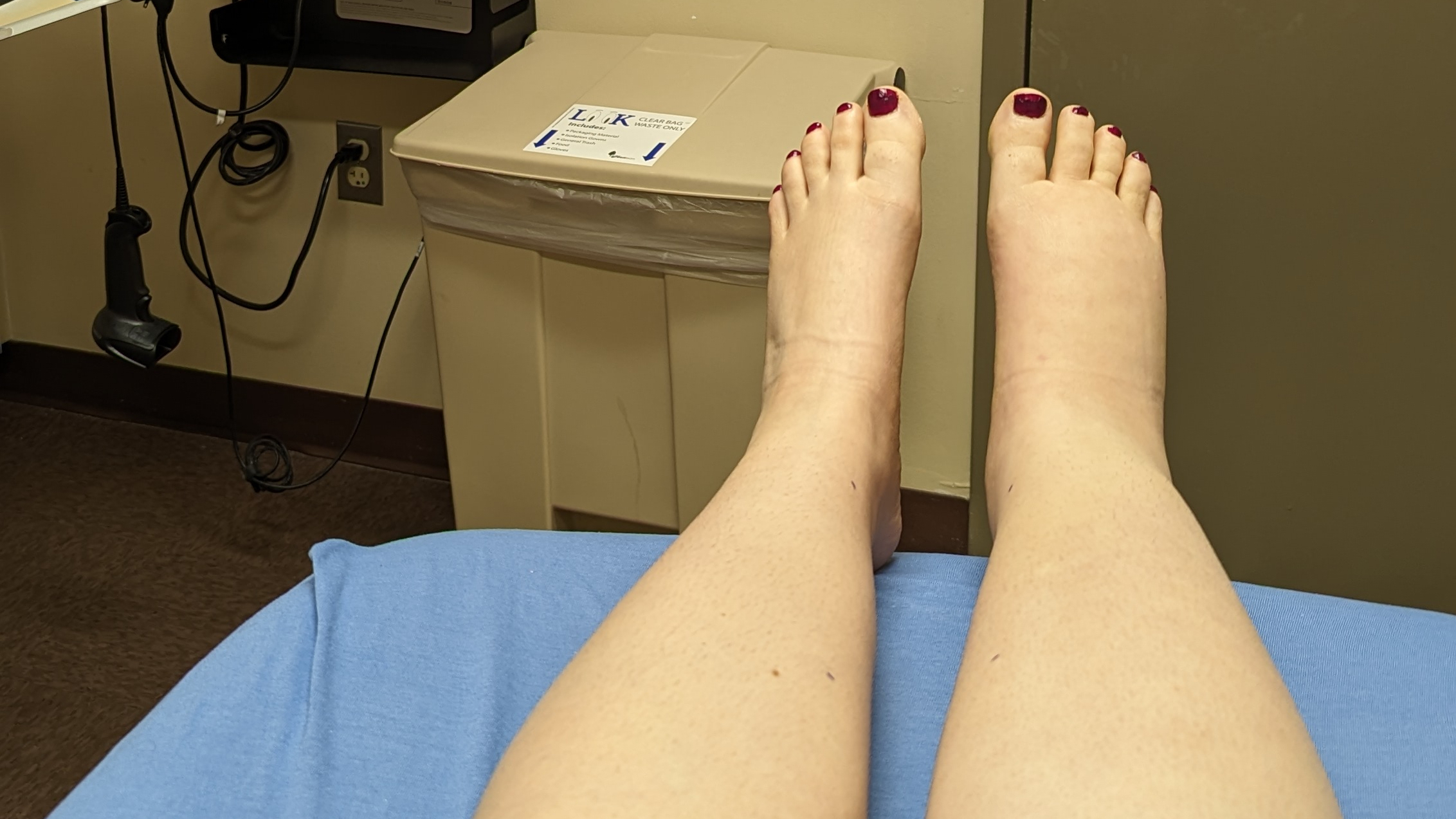Last month I went to my yearly lymphedema check-up, with my friend in tow for support. We settled into an examination room and made small talk with the nurse about work, lymphedema, and the cooling weather as she maneuvered around the exam bed, taking careful measurements of my legs and jotting down the numbers.
After the nurse took my measurements, she asked if I had been noticing any swelling in my left leg — my “good” leg. I told her yes: at the end of the day it’s been a little puffy, something I’ve chalked up to sitting a lot at work and eating too much sodium.
“Thought so,” the nurse said. “While I was measuring your left leg I noticed some slight pitting.” She pressed her fingertip into my lower leg; when she removed it, a brief indentation remained.
She entered my measurements into the computer. As it turns out, my right leg has increased 8.7% in volume since last year’s visit and my left leg — my “good” leg — has increased 12.2%.
I felt a flash of panic. Is this it? Is my lymphedema spreading?
My friend recognized the look on my face and quickly launched into action: “That’s okay, it’s fine! It could be all the lunch meat. Wait and see what the doctor says.”
She was probably right, but I continued to fret. When my doctor arrived, we chatted about how things have been going since my last appointment. As he examined my legs, I shared my fears about my lymphedema spreading to my unaffected limb. He said that’s a valid concern, however this could be regular edema triggered by my already-compromised lymphatic system: perhaps my salty, sedentary habits are making things more sluggish than usual, causing the left leg to swell.
To address the increased swelling and to prepare to be measured for some much-needed new garments, my doctor suggested I do a round of complete decongestive therapy. He said the swelling in my left leg may improve as the right one reduces during treatment; in the meantime, wearing an off-the-shelf compression sock on that leg may provide some relief.

What’s complete decongestive therapy?
Complete decongestive therapy (CDT), also called complex decongestive therapy or combined physical therapy, is considered the “gold standard” treatment for most patients with primary and secondary lymphedema.
CDT is done in two phases: the active or intensive phase and the maintenance phase. The active phase is all about reduction and involves multi-layer compression bandaging, manual lymphatic drainage, and exercise. Once reduced, the patient enters the maintenance phase and wears daily compression garments and bandages to manage the swelling.
CDT can last anywhere from three to eight weeks, although this varies depending on the patient’s needs. I did a wrapping treatment for a month in 2012 and again in 2015, when a suggested week-long tune-up had turned into a month-long series.
My therapy evaluation
Two weeks after my check-up, I went back to the clinic for an evaluation with a physical therapist. She took baseline measurements of my legs and performed manual lymphatic drainage on me, and we discussed my treatment plan and scheduling options.
“I’m not sure how I can fit this in with my work,” I said. “Would I be able to come in just two or three times a week?”
“Oh, no,” she said, shaking her head. “You need to come in every day for it to be effective.”
She explained that, once I’m wrapped, I’ll be coming in five days a week for the first two weeks to be unwrapped, receive manual lymphatic drainage massage, and re-wrapped with layers of foam and bandages.
After two weeks, when my leg has been significantly reduced, I’ll be measured for my new custom garments. In the remaining half of treatment, I’ll come in three days a week for the same routine in order to maintain the reduction until the new garments arrive.

I balked a little: When I did a round of complete decongestive therapy three years ago, I was working part-time and could better accommodate the intense treatment schedule. Now that I have a full-time job, will I be able to make it to multiple appointments a week? How will I handle my daily commute when I’m wearing bulky wraps and a cumbersome surgical shoe?
Health should not be at the mercy of logistics, yet it so often is. I’m stressed just thinking about how to balance these CDT appointments with work and everything else, and on top of that I’m concerned about what’s going on with my left leg.
I know making the time to do this will be worthwhile though, and I want to do it. I need to do it. Outside of work, I’ve been behind on so much lately — my emails, my relationships, my writing. I can’t get behind on my health, too.
Preparing for treatment
Before anything else, I had to let work know what was going on. I spoke with my supervisor about the upcoming treatment and what my needs will be as far as accommodations and time, and together we developed a plan to make sure I won’t miss a beat with my projects.
In the weeks leading up to the first wrapping appointment, I’ve been doing what I can to ensure I get the most out of this round of CDT, including:
- Wearing off-the-shelf compression on my left leg to help relieve the swelling.
- Lessening my sodium intake and drinking more water.
- Taking notes on my symptoms and potential triggers so as to get some insight into what’s causing the swelling in my left leg.
- Using my pneumatic compression pump more regularly.
- Elevating, especially at work and overnight.
- Performing manual lymphatic drainage and practicing diaphragmatic breathing (especially while elevating at home).
If there’s one thing I’ve learned through the ups and downs of my life with lymphedema, it’s this: when the going gets tough, the tough get elevated. My increased swelling is not something to despair about, but rather a call to action for me to re-commit to my treatment and make adjustments as needed.
I get wrapped the day after tomorrow, on Monday morning. Although I’m not thrilled about a month of early-morning appointments and what will probably be a lot of redundant questions about my leg, I feel ready. This has been long overdue.





Leave a Reply